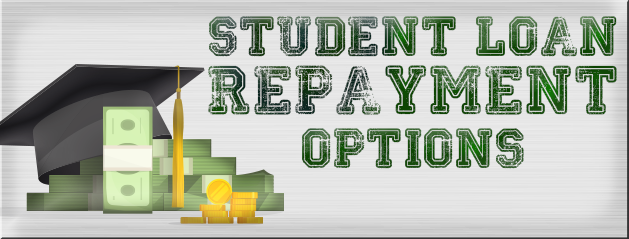Repayment

Are you graduating, borrowed student loans and are worried about making payments? Perhaps your student loans are already in repayment and you are struggling to make those payments. Do not despair, there are several options available to help you stay on track and alleviate some of your worries. Let us begin with the following steps:
If you are unsure who your loan servicer is, please visit https://nslds.ed.gov/nslds/nslds_SA in order to find out. Remember that you will need to contact each of your loan servicers if you have more than one.
If you are unemployed, enrolled in school, or suffering through an economic hardship you can possibly qualify for a deferment. A deferment temporarily postpones your payments and the interest on subsidized loans for a specified amount of time. Another option may be a forbearance, which may postpone your payment but the interest will continue to accrue on all loans. You can contact your loan servicer if you would like to discuss your repayment plan options or change your repayment plan here. If your current loan payment is causing a strain on your finances or you simply cannot afford it then you may be eligible for a different repayment plan that can reduce your payment amount. You will need to contact your loan servicer in order to determine your eligibility. Please keep in mind that the amount of interest paid can be greater if you change repayment plans. Below are the different repayment plans available and you can compare them by clicking on the following link Student Loan Repayment Comparison Calculator. The IBR / ICR are alternative student loan repayment plans that establish a monthly payment that takes your unique situation into account by considering the following criteria: Any outstanding principal and interest still owed after 25 years of qualifying payments will be forgiven. The Graduated Repayment Plan offers smaller payments at the beginning of the repayment period and gradually increases over the repayment period. No single payment will be more than three times greater than any other payment and the repayment period is for ten years. The Extended Repayment Plan lengthens the repayment term up to 25 years. Payments can be.How to postpone your payments
Alternative Repayment Plans
Income Based Repayment (IBR) / Income Contingent Repayment (ICR)
Graduated Repayment Plan
Extended Repayment Plan
Now that you have explored your options it is now time to contact your loan servicer. Do not delay in contacting your loan servicer if you are already in repayment. Falling behind on your loan payments can result in late fees and it can negatively affect your credit score.
You’re not alone when it comes to student loans, UTRGV has partnered with Inceptia, a division of National Student Loan Program (NSLP), to provide you with FREE assistance on your Federal student loan obligations to ensure successful, and comfortable, loan repayment. Inceptia’s friendly customer representatives may reach out to you if your loan(s) become delinquent.
Inceptia is not a collection agency. We’ve partnered with them to help you explore a wide variety of possibilities such as alternative repayment plans, deferment, consolidation, discharge, forgiveness, and forbearance options. Inceptia will stay in touch with you via phone calls, letters, and/or emails to help you find answers to your questions and solutions to your issues.
For additional resources including information on repayment options, please visit Inceptia’s Federal Student Loan Overview website at Inceptia.org/FAQ.
If you have any further questions or concerns, feel free to contact our Default Management Office at (956) 665-2144 or via email at manageyourloans@utrgv.edu.
Things that may interest you:
- Loan repayment assistance through the Loan Repayment Program for Mental Health Professionals( Click Here)
- Loan repayment assistance through the Nursing Faculty Loan Repayment Assistance Program( Click Here)
- Loan repayment through the Peace Officer Loan Repayment Assistance Program ( Click Here)
- Loan Forgiveness, Cancellation, and Discharge Programs
- Loan Consolidation: The Pros and Cons
- Beware of Student Loan Debt Relief Scams

seekUT is a free, online tool and website that presents data on the earnings and educational graduate outcomes for UTRGV and other UT System Institutions. Visit seekUT and see what the median salary, debt and jobs statistics for your major or course of study has to offer all in one place.
________________________________________________________________________________
UTRGV Average Student Loan Debt and 3-YR CDR vs State and National
The information below represents three years of historical data for UTRGV’s average student loan debt and 3-YR Cohort Default Rate (CDR) in comparison to the State and National averages.
3 Year Historical Data
| Average Student Loan Debt: | FY 2019 | FY 2018 | FY 2017 |
| UTRGV Average Student Loan Debt | $16,662 | $11,661 | $16,129 |
| % of UTRGV Students Who Borrowed | 55.0% | 59.0% | 59.0% |
| State Average Student Loan Debt | $26,951 | $27,293 | $27,986 |
| National Average Student Loan Debt | $27,539 | $29,200 | $28,650 |
| 3-YR CDR Rate: | FY 2019 | FY 2018 | FY 2017 |
| UTRGV 3-YR CDR Rate | 0.1% | 0.9% | 4.8% |
| State Average 3-YR CDR Rate | 3.6% | 10.3% | 12.7% |
| National Average 3-YR CDR Rate | 1.8% | 7.3% | 9.7% |
Source
:
Federal Student Aid: Official Cohort Default Rates for Schools
(
https://www2.ed.gov/offices/OSFAP/defaultmanagement/cdr.html)
Source
:
The Institute for College Access & Success (TICAS): Project on Student Debt
(
https://ticas.org/our-work/student-debt/)
